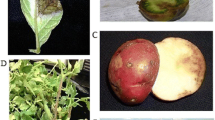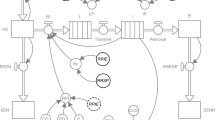Abstract
The 1:1 ratio of the Phytophthora infestans A1 and A2 mating types favors the sexually derived genetic diversity of the late blight pathogen of potatoes, which is widespread in the central highlands of México. This ratio guarantees the successful infection of this pathogen, even in resistant potato hosts. However, wild Solanum species present in the region serve as alternative hosts to the pathogen. Knowledge about the external factors that influence the dynamics of this disease facilitates the assessment and selection for genetically resistant potato cultivars to late blight, in addition to providing the capacity to predict epidemics. This work aimed to assess the expected, observed, and simulated progress of natural P. infestans infection of potatoes during two epiphytotic field seasons (2009 and 2010) at Chapingo, México. Using 8-years of weather datasets, six ideal situations were predicted with four to eight infection cycles of 6 to 12 h each. In comparison to the predictions, the observed effect of the area under the disease progress curve, and its components (AUDPC, RAUDPC, RaRAUDPC), was highly significant, with a low coefficient of variation among the potato cultivars used in the study. In conclusion, we confirm that the LATEBLIGHT-LB2004 model is useful for simulating and predicting late blight epidemics based on the weather conditions of Chapingo, except for the magnitude of the relative humidity threshold variable (RH_threshold), which requires calibration for each cultivar.
Resumen
La proporción 1:1 de los grupos de compatibilidad A1 y A2 de Phytophthora infestans favorece la diversidad genética derivada sexualmente del patógeno del tizón tardío de la papa, que está ampliamente distribuido en los altiplanos centrales de México. Esta proporción garantiza la infección exitosa del patógeno, aún en hospedantes de papa resistentes. No obstante, las especies silvestres de Solanum presentes en la región sirven como hospederos alternantes del patógeno. El conocimiento de los factores externos que influencian la dinámica de esta enfermedad facilita el análisis y la selección para la resistencia genética de variedades de papa al tizón tardío, además de proporcionar la capacidad de predecir epidemias. El propósito de este trabajo fue analizar el progreso de la infección natural de P. infestans respecto a lo esperado, observado y simulado en papa durante dos ciclos de campo epifíticos (2009 y 2010) en Chapingo, México. Con el registro de ocho años de datos meteorológicos, se predijeron seis situaciones ideales con cuatro a ocho ciclos de infección de 6 a 12 hs cada uno. En comparación con las predicciones, el efecto observado de área bajo la curva de progreso de la enfermedad, y sus componentes (AUDPC, RAUDPC, RaRAUDPC), fue altamente significativo, con bajo coeficiente de variación entre las variedades de papa usadas en este estudio. En conclusión, confirmamos que el modelo LATEBLIGHT-LB2004 es útil para simular y predecir la epidemia de tizón tardío, con base a las condiciones atmosféricas de Chapingo, excepto por la magnitud del umbral de la variable de humedad relativa (RH_threshold), que requiere de calibración para cada variedad.




Similar content being viewed by others
References
Alarcon-Rodriguez, N.M. 2011. Caracterizacion de la diversidad genetica de Phytophthora infestans (Mont de Bary) en Chapingo Mexico. Ph.D. Thesis, Universidad Autonoma Chapingo. 82pp.
Andrade-Piedra, J.L. 2005d. Potato late blight: modification, validation and qualification of the late blight model. Ph.D. Thesis, Cornell University. 107 pp.
Andrade-Piedra, J.L., R.J. Hijmans, G.A. Forbes, W.E. Fry, and R.J. Nelson. 2005a. Simulation of potato late blight in the Andes. I: Modification and parameterization of the LATEBLIGHT model. Phytopathology 95: 1191–1199.
Andrade-Piedra, J.L., R.J. Hijmans, H.S. Juarez, G.A. Forbes, D. Shtienberg, and W.E. Fry. 2005b. Simulation of potato late blight in the Andes. II: Validation of the LATEBLIGHT model. Phytopathology 95: 1200–1208.
Andrade-Piedra, J.L., G.A. Forbes, D. Shtienberg, N.J. Grünwald, M.G. Chacon, M.V. Yaipe, R.J. Hijmans, and W.E. Fry. 2005c. Qualification of a plant disease simulation model: Performance of the LATEBLIGHT model across a broad range of environments. Phytopathology 95: 1412–1422.
Blandon-Diaz, J.U., G.A. Forbes, J.L. Andrade-Piedra, and J.E. Yuen. 2011. Assessing the adequacy of the simulation model LATEBLIGHT under Nicaraguan conditions. Plant Disease 95: 839–846.
Cadena-Hinojosa, M.A., M. Diaz-Valasis, R.A. Guzman-Plazola, S. Fernandez-Pavia, and N.J. Grunwald. 2007. Late blight resistance of five mexican potato cultivars in the eastern sierra of the state of the Mexico. American Journal of Potato Research 84: 385–392.
Campbell, C.L., and L.V. Madden. 1990. Introduction to plant disease epidemiology. New York, USA: Wiley. 532pp.
CIP (Centro Internacional de la Papa). 2010. Procedimientos para pruebas de evaluaciones estándar de clones avanzados de papa. Guía para Cooperadores Internacionales. 151pp.
CIP (International Potato Center). 2007. Procedures for standard evaluation trials of advanced potato clones. An international cooperators’ guide, eds. M. Bonierbale, S. de Haan, A. Forbes. International Potato Center. 124pp.
Erwin, D.C., and O.K. Ribeiro. 1996. Phytophthora Diseases Worldwide. The American Phytopathological Society. St. Paul: APS Press. 562pp.
Forbes, G.A., W.E. Fry, J.L. Andrade-Piedra, and D. Shtienberg. 2008. Simulation models for potato late blight management and ecology. In: eds. A. Ciancio, K. G. Mukerji. Integrated management of diseases caused by fungi, phytoplasma and bacteria. Pp: 161–177.
Fry, W.E. 1978. Quantification of general resistance of potato cultivars and fungicide effects for integrated control of late blight. Phytopathology 68: 1650–1655.
Garcia, M.E. 1987. Modificaciones al sistema de clasificación climática de Köppen. Cuarta edición. Enriqueta García de Miranda. México, D. F.: Universidad Nacional Autónoma de México. 217 p.
Goodwin, S.B. 1996. Origin and ecology of Phytophthora infestans. Revista Mexicana de Fitopatología 14: 143–147.
Grünwald, N.J., W.C. Flier, A.K. Sturbaum, E. Garay-Serrano, T.B.M. van de Bosch, C.D. Smart, J.M. Matuszak, H. Lozoya-Saldaña, L.J. Turkensteen, and W.E. Fry. 2001. Population structure of Phytophthora infestans in the Toluca Valley region of central México. Phytopathology 91: 882–890.
Hamester, W., and U. Hils. 1999. World catalogue of potato varieties. Buchedition Agrimedia GmbH Spithal 4. Germany: 29468 Bergen/Dumme. 208 pp.
Haynes, K.G., and D.P. Weingartner. 2004. The use of area under the disease progress curve to assess resistance to late blight in potato germplasm. American Journal of Potato Research 81: 137–141.
Henfling, J.W. 1987. Late blight of potato: Phytophthora infestans. Technical information bulletin 4. International Potato Center, Lima, Peru. (Second edition, revised). 25 pp.
Iglesias, I., O. Escudero, C. Seijo, and J. Mendez. 2010. Phytophthora infestans prediction for a potato crop. American Journal of Potato Research 87: 32–40.
Jeger, M.J., and S.L.H. Viljanen-Rollinson. 2001. The use of the area under the disease-progress curve (AUDPC) to assess quantitative disease resistance in crop cultivars. Theoretical and Applied Genetics 102: 32–40.
Johnson, D.A., T.F. Cummings, R.A. Ghanem, and J.R. Alldredge. 2009. Association of solar irradiance and days of precipitation with incidence of potato late blight in the semiarid environment of the Columbia Basin. Plant Disease 93: 272–280.
Kamoun, S., and C.D. Smart. 2005. Late blight of potato and tomato in the genomics era. Plant Disease 89: 692–699.
Lozoya, S.H. 2006. Reporte anual. programa internacional cooperativo del Tizón Tardío de la papa. México: A.C. Departamento de Fitotecnia, Universidad Autónoma Chapingo. 20 pp.
Maila, G., A. Taipe, G. Forbes, y J. Andrade-Piedra. 2011. Validación del simulador de epidemias LATEBLIGHT “LB2004” con clones precoces y resistentes de papa (Solanum tuberosum). Pp. 124–127. In: eds. J. Andrade-Piedra, I. Reinoso, S. Ayala. 2011. Memorias del IV Congreso Ecuatoriano de la papa. Guaranda-Ecuador. 131pp.
Morales, W., P. Taipe, y G. Forbes. 2011. Concentración e infección de esporangios de Phytophthora infestans (Mont) de Bary en pre-emergencia de tubérculos de papa (Solanum tuberosum). Pp: 69–71. In: eds. J. Andrade-Piedra, I. Reinoso, S. Ayala. 2011. Memorias del IV Congreso Ecuatoriano de la papa. Guaranda-Ecuador. 131 pp.
Nowicki, M., M.R. Foolad, M. Nowakowska, and E.U. Kozik. 2012. Potato and tomato late blight caused by Phytophthora infestans: An overview of pathology and resistance breeding. Plant Disease 96: 4–17.
Romero-Montes, G., H. Lozoya-Saldaña, S. Fernandez-Pavia, and N.J. Grünwald. 2011. Phytophthora infestans oospore distribution in soil of the Toluca Valley, Mexico. Revista Mexicana de Fitopatologia 29: 25–38.
Romero-Montes, G., H. Lozoya-Saldaña, G. Mora-Aguilera, S. Fernandez-Pavia, and N.J. Grünwald. 2012. Potato yield regard to late blight (Phytophthora infestans Mont. de Bary) epiphytotics. Revista Fitotecnia Mexicana 35: 69–78.
Rubio-Covarrubias, O.A, A. Rivera-Peña, J.A. Rangel-Gonzalez, M. Cadena-Hinojosa, R. Flores-Lopez, R. Rocha-Rodriguez, J.V. Magallanes-Gonzalez, C. Ortiz-Trejo, C. Diaz-Hernandez, H. Lopez-Delgado, T.E. Zavala-Quintana, M. Diaz-Valassis, y A. Paredes-Tenorio. 2000. Manual para la producción de papa en las sierras y valles altos del centro de México. Instituto Nacional de Investigaciones Forestales, Agrícolas y Pecuarias, Zinacantepec, Estado de México, México. Libro Técnico No. 1. División Agrícola. 67pp.
SAS Institute Inc. Cary. 2002. SAS Online Doc® 9. Cary, NC: SAS Institute Inc.
Shaner, G., and R.E. Finney. 1977. The effect of nitrogen fertilization on the expression of slow mildewing resistance in Knox wheat. Phytopathology 67: 1051–1056.
Skelsey, P., W.A.H. Rossing, G.J.T. Kessel, and W. van der Werf. 2009. Scenario approach for assessing the utility of dispersal information in decision support for aerially spread plant pathogens, applied to Phytophthora infestans. Phytopathology 99: 887–895.
Skelsey, P., W.A.H. Rossing, G.J.T. Kessel, and W. van der Werf. 2010. Invasion of Phytophthora infestans at the landscape level: How do spatial scale and weather modulate the consequences of spatial heterogeneity in host resistance? Phytopathology 100: 1146–1161.
Spooner, D.M., van den Berg, R.G., Rodríguez, A., Bamberg, J., Hijmans, R.J. and Lara-cabrera, S.I. 2004. Wild potatoes (Solanum Section Petota: Solanaceae) of north Central America. Systemic Botany Monographs, Vol. 68. American Society of Plant Taxonomists. 209pp.
Taipe, A., G. Forbes, y J. Andrade-Piedra. 2011. Estimacion del nivel de susceptibilidad a Phytophthora infestans en genotipos de papa. pp: 72–74 eds. J. Andrade-Piedra,I. Reinoso, S. Ayala. 2011. Memorias del IV Congreso Ecuatoriano de la papa. Guaranda-Ecuador. 131 pp.
Yuen, J.E., and G.A. Forbes. 2009. Estimating the level of susceptibility to Phytophthora infestans in potato genotypes. Phytopathology 99: 782–786.
Acknowledgments
This study was supported by the Autonomous University of Chapingo, Mexico, and all the experiments comply with the current laws of México. The constructive comments and suggestions provided by Dr. Peter Schmiediche and Dr. Charles R. Brown are greatly appreciated.
Author information
Authors and Affiliations
Corresponding author
Rights and permissions
About this article
Cite this article
de la Cruz, J.B.D., Lozoya-Saldaña, H., Sahagún-Castellanos, J. et al. The Pathosystem Solanum tuberosum L.-Phytophthora infestans (Mont.) de Bary in Chapingo, Mexico. Expected, Observed, and Simulated. Am. J. Potato Res. 91, 312–326 (2014). https://doi.org/10.1007/s12230-013-9351-y
Published:
Issue Date:
DOI: https://doi.org/10.1007/s12230-013-9351-y




